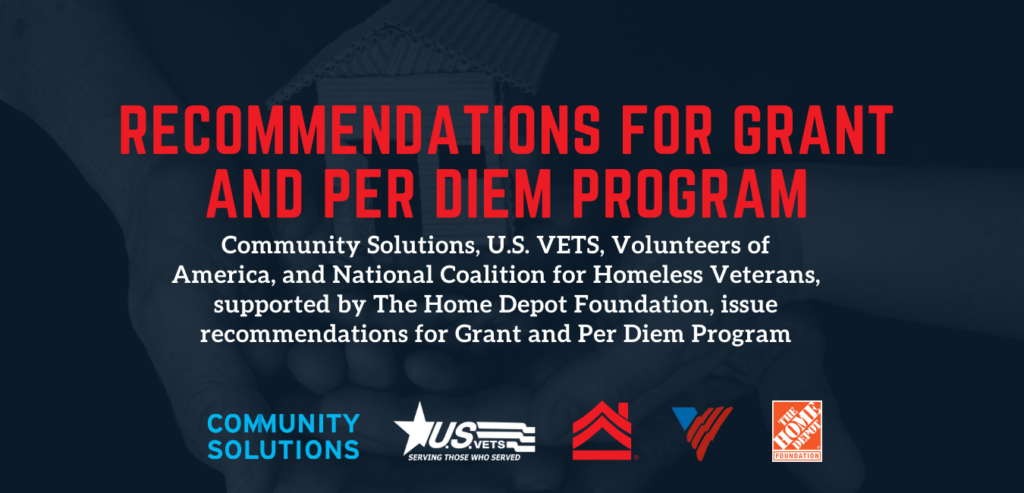
An opportunity to seize the moment to end veteran homelessness
Our nation has made tremendous progress in reducing and ending veteran homelessness. In the next few years, we have an opportunity to finish the job.
Numerous communities across the country have already demonstrated that it is possible to end veteran homelessness across a region. To date, 12 US communities participating in Built for Zero have achieved functional zero, and 82 communities and 3 states have achieved the Federal Benchmarks and Criteria on Ending Veteran Homelessness.
Support from the federal government was critical to this success. The Obama administration’s commitment to end veteran homelessness set the stage for many communities to make progress towards zero. Under the Biden administration, we see a pathway to helping communities make veteran homelessness rare and brief when it occurs, everywhere.
The progress that our country has made offers not only an opportunity to recognize what got us this far, but to reassess changes to funding, policies, and provider capacity needed to go even farther. As national organizations committed to making veteran homelessness rare and brief, we worked to identify high leverage opportunities to accelerate this work. We drew upon our diverse experiences, which includes working directly with communities on systemic change, advocating for policy change, and providing transitional and permanent housing to veterans experiencing homelessness.
Together, we — Community Solutions, U.S.VETS, Volunteers of America, and National Coalition for Homeless Veterans, supported by The Home Depot Foundation — have identified two key opportunities to make sure we finish the job.
- Our nation must maintain or increase the level of funding targeted to permanently ending veterans’ homelessness.
- We must address remaining policy constraints across all programs that restrict communities from fully deploying and making optimal use of all existing resources. We have identified the U.S. Department of Veterans Affairs (VA) Grant and Per Diem program as one of the most critical resources that would be catalytic if greater flexibility is granted to its operators.
The critical role of Grant and Per Diem Program
The U.S. Department of Veterans Affairs (VA) Grant and Per Diem (GPD) program currently funds transitional housing facilities on a per diem basis across a robust portfolio of models. This includes bridge housing, low demand, clinical treatment, transition-in-place, hospital to housing, and service-intensive. As of the end of 2020, there were over 12,300 active GPD beds, serving over 25,000 Veterans over the course of the year.
This program was established with an understanding that veterans need support in the communities where they live, and that offering this support, when veterans face an urgent housing crisis, is critical. But as the actively homeless number of veterans continues to decrease, and as we do a better job of preventing veteran homelessness, we expect that program occupancy will decrease in certain communities, which will create opportunities to repurpose those resources to match the evolving needs of this population.
We can respond to this changing context by enabling GPD operators to repurpose excess resources to help even more veterans exit homelessness and achieve housing stability as quickly as possible. Allowing GPD operators to right size the transitional housing program would enable them to meet a reduced demand for shelter while shifting resources toward supporting housing stability, new types of housing (like Housing-First focused permanent housing), and prevention efforts that can keep veterans out of the homeless response system altogether.
To take full advantage of those opportunities, GPD operators will need the flexibility to switch between approved models as needed, with little bureaucracy, and right size the number of per diem beds in the program based on bed utilization over time.
Summary of Recommendations
The federal government should provide program flexibility and support to providers currently operating Grant and Per Diem (GPD) programs so they can continue to provide necessary support to veterans as communities reduce and end veteran homelessness.
Providers should be granted flexibility to provide prevention services where needed to help veterans access the stability and permanent housing they need, whether that includes rapidly rehousing veterans and families when possible, creating a system designed to address the causes of homelessness, or providing employment, mental health and case management needs. These activities may include:
- Repurposing GPD transitional housing funding for activities associated with operating and serving veterans in permanent housing
- Providing housing stability and homelessness diversion services
- Expanding the use of the TIP (Transition-in-Place) program if the TIP programming dollars could be funded to match local housing market costs.
- Providing HUD-VASH case management, which would also enable providers to respond to a critical shortage of VASH case management services that exists in some communities
VA should also make Technical Assistance support available to current GPD operators that desire support in adapting their programs and services or converting existing GPD facilities to permanent affordable and supportive housing.
VA should conduct and respond to a comprehensive review of all VA homeless resources to ensure that adequate supportive services are available within each model. This should include homeless prevention, transitional housing, aftercare, and permanent supportive housing.
To align GPD funding with current data and projected need, VA should regularly examine the funding of GPD programs in a community at, under, or over the amount requested by that community (providers, VA, and the local CoC). This regular examination should be done in coordination with the providers, local VAMC, CoC lead agency, and other homeless response system actors, as opposed to the direct program-by-program basis employed now. The examination of current data and any right-sizing should not only include point-in-time counts but also:
- the number of unduplicated veterans experiencing homelessness annually in the community;
- the number of veterans exiting GPD transitional housing to permanent housing;
- cost-effectiveness of transitional housing compared to permanent supportive housing;
- the availability of other supportive services in the community; and
- the collectively stated needs of veterans currently and formerly experiencing homelessness.

